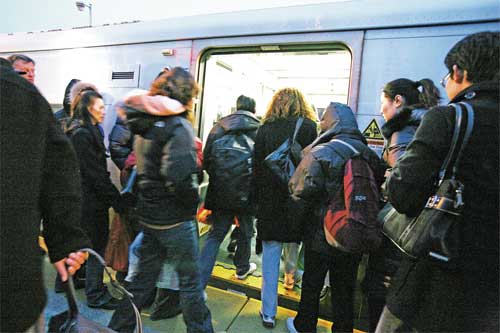By Jeremy Walsh
Mayor Michael Bloomberg's congestion pricing plan is fading into history, but congestion in Queens remains a major problem with no clear solutions.
Borough residents, whose commute is the second longest in the country, spend hours stuck in traffic on the Long Island Expressway, waiting for jammed subway trains on the No. 7 line or switching from a bus to the A train on a 90-minute trip from the Rockaways to Manhattan every day.
Buses fan out across the borough from clogged streets in downtown Flushing and Jamaica, where resolute riders jump into dollar vans to reach outlying neighborhoods where public transit is sporadic at best.
Queens had the longest travel time to work in the country at 41.7 minutes, according to the U.S. Census' 2003 American Community Survey.
Staten Island recently took over the lead from Queens among the five boroughs, with 42.6 minutes spent on average getting to or from work each day, according to 2006 Census figures. Queens was next, with 41.8 minutes, Brooklyn followed with 41.4 minutes, and the Bronx's average was 40.6 minutes. Manhattan had the shortest commute time at 30.1 minutes.
Most people in Queens opposed congestion pricing, concerned that the plan to charge $8 to motorists entering Lower Manhattan during business hours would encourage car commuters to park their vehicles along the borough's already clogged main thoroughfares and side streets and join the crowds on Manhattan-bound subway platforms or bus stops.
The plan was expected to generate $491 million in revenue annually. It would have made use of $344 million in federal funding for more than $1 billion in MTA improvements, with another $10 million to help implement the $8 pricing system. In Queens, those improvements would have included four new express bus routes to Manhattan, three new local routes, and increased bus service on 13 existing routes as well as upgrades to 13 borough subway station.
A January Quinnipiac University poll showed that 58 percent of borough residents were against the plan, although 42 percent said they would prefer it over an alternative plan to place tolls on the East River bridge crossings.
The congestion plan would have affected more drivers from Queens than any other borough. Though the majority of Queens residents use mass transit, the 51,681 Queens residents who drive to work in Manhattan outnumber car commuters from any other borough or outlying area except New Jersey, the Census data showed. The number of Queens drivers comprises 14.6 percent of borough residents working in Manhattan.
Bloomberg's plan died in the state Assembly when legislators, upset with the mayor's unwillingness to compromise, refused to bring the plan to a vote on the floor even though the City Council had approved it. As the federal deadline passed with no plan approved, the federal government awarded the transportation funding to Los Angeles County for congestion pricing toll lanes and to Chicago for bus improvements.
After the congestion pricing measure failed to come to a vote in Albany, Queens officials made it clear that more attention was needed for roadways and railways outside Manhattan.
“Until I see an improvement in existing infrastructure and services to the outer boroughs, I must oppose a congestion pricing plan for Manhattan,” said state Assemblywoman Ellen Young (D-Flushing). “We must remember to be fair to all sectors of this city.”
Most of the borough's work force already use subways, buses or the Long Island Rail Road without any prodding from congestion pricing, Census figures show. Of the 1 million workers living in the borough, 513,949 take mass transit to work, 329,379 drive alone, 79,980 carpool and 58,542 walk to work.
The majority of Queens workers 563,886 out of nearly 1 million head to jobs outside the borough, overwhelmingly in Manhattan, where 346,268 commute each day.
With most of the borough's employed heading into Manhattan each day along with the bulk of commuters from Long Island, roadways and subways are clogged long before commuters cross the bridges into the city and face the congestion lamented by Bloomberg.
But the East River crossings are not the only routes in Queens that see heavy rush hour traffic. Some 87,350 Queens residents commute to Brooklyn, 18,373 head to the Bronx, and 5,249 commute to Staten Island. Outside of New York City, 65,125 Queens residents commute to Nassau County.
Traffic backs up on inter-borough connectors like the Brooklyn Queens Expressway and the Throgs Neck Bridge. The eastbound Long Island Expressway and Grand Central Parkway are clogged each morning with drivers bound for Long Island locations.
That does not make Queens a desert during the day, however. While many Queens residents go elsewhere, 367,823 Queens residents also work in the borough, Census figures show. The borough also sees an influx of 66,085 workers from Nassau County and 62,255 from Brooklyn.
Aaron Davis contributed to this story.
Reach reporter Jeremy Walsh by e-mail at jwalsh@timesledger.com or by phone at 718-229-0300, Ext. 154.
































